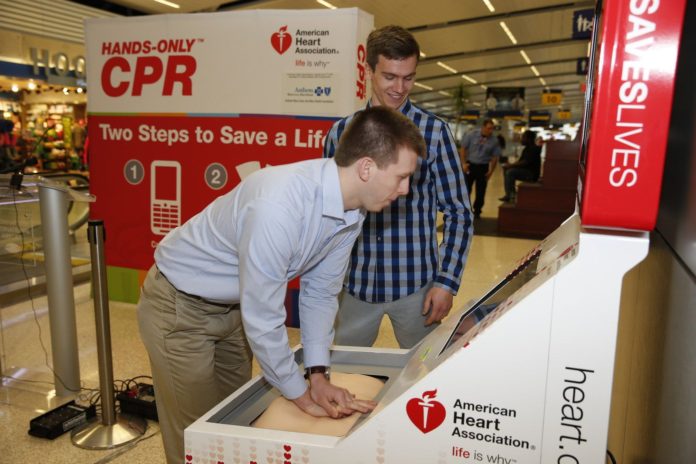The American Heart Association is taking CPR training on the road. The Dallas organization devoted to fighting cardiovascular disease is debuting Hands-Only CPR training kiosks at select international airports across the United States. The pilot kiosk was introduced at Dallas Fort Worth International Airport in 2013. The newest kiosks are at Cleveland Hopkins International, Cincinnati/Northern Kentucky International and Orlando International airports, bringing the total to seven in the United States.
Using the training kiosks the public can learn Hands-Only CPR in about five minutes while they wait for their flights. The kiosks are supported by Anthem Foundation, the philanthropic arm of Anthem Inc.
One cardiac arrest survivor is Sean Ferguson. He and Matt Lickenbrock were in a parking lot at the University of Dayton when Ferguson was struck by lightning and suffered cardiac arrest. Lickenbrock had learned Hands-Only CRP at the training kiosk at DFW Airport in April 2015 and used that training only days later to help Ferguson, according to the AHA. A video of the two is part of the Hands-Only CPR training.
Researchers evaluated data from the AHA’s pilot kiosk at DFW Airport during a 32-month period. The study found noticeable interest by the public in learning Hands-Only CPR as nearly 23,500 people used the kiosk from July 2013 to February 2016.
“Only 46 percent of people who suffer an out-of-hospital cardiac arrest receive bystander CPR before professional help arrives,” said Dr. Clifton Callaway, a volunteer on the AHA’s Emergency Cardiovascular Care Committee and professor of emergency medicine at the University of Pittsburgh. “The airport kiosks have proven to be an invaluable approach to introduce CPR to people, making it more likely they’ll respond if they encounter a cardiac arrest victim outside the hospital.”
Each year, more than 350,000 cardiac arrests occur outside a hospital, and about 20 percent occur in public places such as airports, according to AHA. Hands-Only CPR has been shown to be as effective as conventional CPR for cardiac arrest when it occurs in public, and CPR can double or triple a victim’s chance of survival, according to AHA. The interactive kiosks are designed to train large numbers of people on this lifesaving technique.
Hands-Only CPR has two steps, done in this order: if you see a teen or adult suddenly collapse, call 911. Then, push hard and fast in the center of the chest until help arrives. Each kiosk has a touch screen with a short video that provides an overview of Hands-Only CPR, followed by a practice session and a 30-second test. With the help of a practice manikin, or a rubber torso, the kiosk gives feedback about the depth and rate of compressions, as well as proper hand placement – factors that influence the effectiveness of CPR.
More than 20,000 people have learned Hands-Only CPR from the AHA kiosks installed in 2016 at O’Hare International, Indianapolis International, Hartsfield-Jackson Atlanta International and Baltimore-Washington International airports.
To learn more about the Hands-Only CPR campaign, visit heart.org/handsonlycpr.






